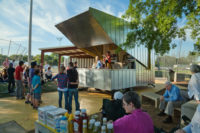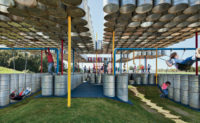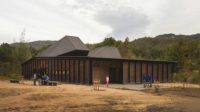Driving along Alabama’s State Route 61 is like a journey through the land that time forgot. Past catfish ponds and rolling pastures, the highway pauses for a moment where it swells to form downtown Newbern (population 189), a rustic collection of warehouses and storefronts from the turn of the last century. But over the last couple of decades, Rural Studio, Auburn University’s design-build program, which is based here, has left its mark, erecting a fire station and other structures. For its latest endeavor, the school has transformed a diminutive masonry bank building into a modern, 1,600-square-foot library—Newbern’s first—that maintains the local down-home spirit while providing an inviting community resource.
Additional Content:
Jump to credits & specifications
The building has a typical American story. Built in 1906 as the Bank of Newbern, it went on to have a varied life after the financial institution failed during the Great Depression. It housed an insurance office, a livestock-feed storage facility, and then sat empty, occasionally serving a stint as a polling center. In 2012, the owner, a local family, donated the use of the building to Rural Studio. The town postmaster had been pushing for a library, and, later that year, four thesis-year students were assigned to the project. In Rural Studio tradition, the small team oversaw the planning, design, and construction over the next 24 months. “The students not only design and build,” points out acting director Xavier Vendrell, “they work with the community to figure out what they need and define the organization behind the building.”
The team realized more space would be needed to accommodate a flexible program for both private study and a host of social and educational activities for a wide range of age groups. “There were two basic questions,” says team member Will Gregory. “How do you preserve this old building? And what does the new small-town library look like?” Restoring the front and side facades, the students pushed out the building’s back with a 700-square-foot extension, clad in locally sourced cypress to differentiate it from the masonry. Inside, in the long, open reading room, the new and the old connect seamlessly, with birch plywood ceilings and CNC-milled shelves lining the interior. A row of alcoves along the building’s north side contains computer stations (with the town’s first public Internet access), study nooks, a deep window seat, and restrooms and storage, while a shaded courtyard allows study and gatherings to flow outside. The team salvaged over 8,000 bricks from the old vault, using them for paving and low walls in this area. They rescued other original elements, such as the vault door, which hangs near the entry, and the teller counter, which was repurposed as the librarian’s desk.
This little project reflects many ideas that have shaped the recent designs of larger libraries around the world, as digital technologies have emerged and these civic institutions have reconsidered their role in the community. But it does so without losing sight of its roots and the people it is now serving in this corner of 21st-century small-town America.
CreditsArchitect: Rural Studio, Auburn University PO Box 278, Newbern, AL 36765 334-624-4483 T 334-624-6015 F
Personnel in architect's firm who should receive special credit: Student design & build team: Morgan Acino, Ashley Clark, Stephen Durham, Will Gregory Faculty team: Director Andrew Freear, Instructors: Elena Barthel, Xavier Vendrell, Dick Hudgens AIA , Steve Long, Mackenzie Stagg, Cameron Acheson, John Marusich, Alex Henderson, Johnny Parker
Architect of record: David Hinson Architect, FAIA, Auburn, Alabama
Engineers Structural Engineer: Joe Farruggia - GFGR, Inc. Architects & Engineers, Chicago, Illinois
Consultants Detail consultant: Dan Wheeler – Wheeler Kearns Architects, Chicago, Illinois; Environmental Consultants: Sarah Fisher, Emilie Hagen, Claire Maxfield, and Paul Stoller – Atelier Ten; Acoustic Consultant: Gaines Hall, FAIA, University of Illinois at University of Illinois at Urbana-Champaign, Illinois; Graphic Design Consultant: Clifton Burt, Portland, Oregon
Photographer: The Arkansas Office - Timothy Hursley
|
SpecificationsStructural System Manufacturer of any structural components unique to this project: Wood I-Beam and FiberStrong Rim Board: Georgia Pacific/Boise Cascade
Exterior Cladding Cypress Novelty Siding: Plantation Cypress Bleaching Oil: Cabot Aura Exterior Paint: Benjamin Moore
Roofing EverGuard TPO 60 Mil Membrane: GAF
Windows Wood frame: Architect Series Double-Hung Window: Pella
Glazing Skylights: 14” Solatube: Kistler McDougall Corp.
Doors Entrances: 190 Series Narrow Stile Entrance: Kawneer
Interior Finishes Acoustical ceilings: Custom CNC-Milled Birch Plywood Cabinetwork and custom woodwork: Custom CNC-Milled Birch Plywood Paints and stains: Krystal High Solids Conversion Varnish: M.L. Campbell Homogenous Cork Parquet Tile: US Floors Carpet Tiles: FLOR
Furnishings Acuity Work Chair: Allsteel Chairs: Spark Side Chairs: Knoll Spark Lounge Chairs: Knoll Tables: Custom Steel Frame Tables Other furniture: Kik-Step Step Stools: Cramer
Lighting Downlights: Haiku 60 Ceiling Fan with integrated LED: Big Ass Fans Tasklighting: Z-Bar Solo LED Desk Lamps: Koncept Dimming system or other lighting controls: Roller Shades: Hunter Douglas Contract
Plumbing Talis E Single-Hole Faucet: Hansgrohe Wall Mount Sinks: WS Bath Collections Yard Hydrant: Merrill Mfg.
Energy Other unique products that contribute to sustainability: Ducted Single Zone Air Conditioning System: LG
|









Post a comment to this article
Report Abusive Comment